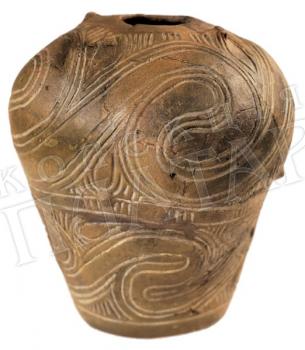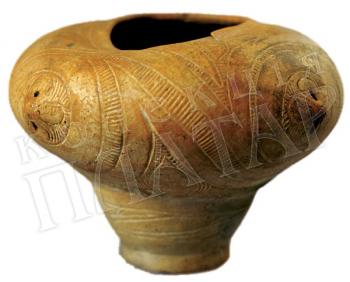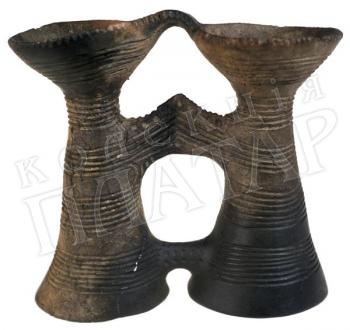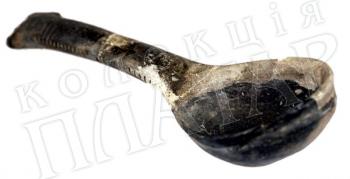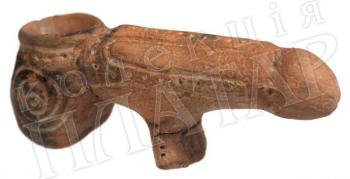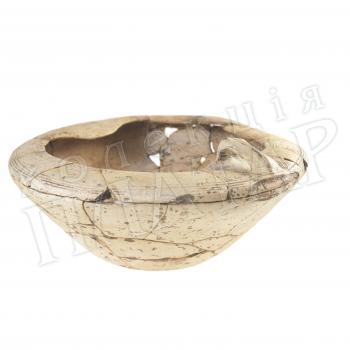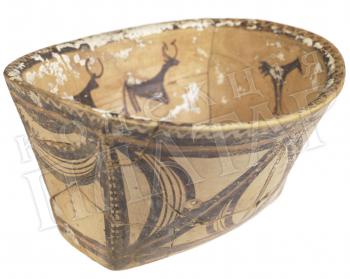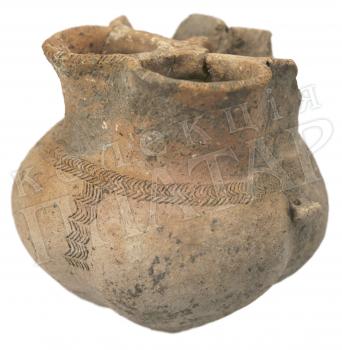Pear shaped peace of plate, without neck, with round hole of orifice and two horizontal ears located near it. The surface is arrayed with curve-line deepened décor in view of belt consisted of three chutes, which create on the shoulders four double delineation of snakes. An article is divided in two parts by horizontal cincture with four clay sculpts. Shaded background in deltoid interspaces between the pictures of snakes is filled by tear-shaped figures. The surface before the decrepitation was engobed.
Trypilska civilization. Copper Age
In the prehistoric past of Ukraine it is possible to find quite a bit of bright events and phenomena which defined subsequent history of the land. Appearance of Trypilska protocivilization, which left us in the inheritance numerous tracks of one of the oldest and the brightest agricultural civilizations of prehistoric Europe, became one of such episodes.
It existed for two thousand years - from the second half of the sixth to the first quarter of the third millennium B.C. According to the archaeological periodization this period is called the late Stone Age, Copper-Stone Age, or Copper Age in the Balkans and in Ukraine. The time of existence of the civilization of Trypilla, border of the IV–III millennium B.C., is referred to the early Bronze Age.
Nowadays antiques of the Trypilska civilization are known in Romania, Moldova and Ukraine. Traces of this old civilization are found in the area ranging from the Carpathians in the west to the Middle Dniester in the east, from Volhynia in the north to the coast of the Black sea in the south.
The Trypilska civilization in the VI–III millennium B.C. was an essential part of the civilization of Old Europe, its eastern outpost. In the IV millennium B.C. on the territory inhabited by the transmitters of the Trypilska civilization, arose the biggest in Europe of that time settlements-protocities, and this region became one of the most developed on a continent for a thousand years.
The achievements of the Trypilians in the industry of handicrafts — metal-working and ceramics — are astonishing. Knowledge about blacksmith’s treatment of copper, the modes of heat treatment and casting in some aspects do not yield to the modern level of knowledge in this industry. The Trypilians introduced the rotary tool in the ceramics, two-tier furnaces for the burning-out of the pottery.
Antiques represented in the collection enables to make the comprehensive picture of the world of the Trypilska civilization and of the people who created it on the territory of Ukraine in VI–III thousand B.C.
This is pottery, the anthropomorphous and zoomorphic plastic arts, the models of temples, the instruments and the weapon, made of copper, stone, bones. Some wares are unique and do not have analogues among the finds done for the last hundred years of research of sights of Trypilla.
The models of buildings made of clay, dated by the end of the V — beginning of the IV millennium B.C., are the standards of the cults wares, which could be used during the ceremonies related to building. The features of architecture and exceptional riches of their finishing allow assuming that before us are the models of old temples. To these buildings, and also to symbolism which decorates them, analogies are found in the old architecture of Mesopotamia and Egypt of V–II millennium B.C. Without overstatement, they can change the permanent picture of architecture of the time of Copper Age on the territory of Ukraine.
The oldest wares are decorated with a mortise ornamental pattern and incrustation, and the latest — the accomplished painting one or two paints. Ceramic wares demonstrate the development of handicraft trade and the evolution of the artistic styles during three thousand years on lands from the Dniesterin in the west to the Dniperin in the east.













